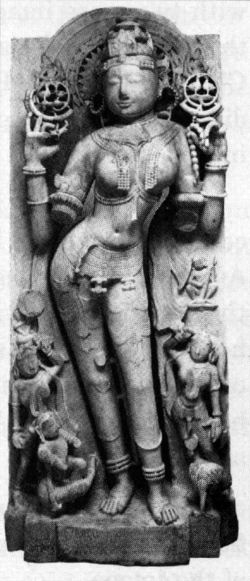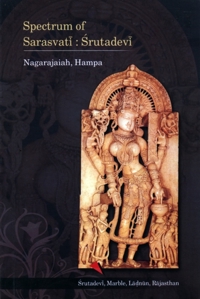 |
63 Gujarāt,1153 CE |
Similarly, the four-armed image of Padmāvatīdevī seated in padmāsana posture on the wall of the same Jinanāthapura temple, and the one consecrated in the Akkana Basadi at Śravaṇabeḷagoḷa, partially resembles the sculptures of Jinanāthapura in some of its details, particularly in holding pāśa and aṅkuśa in her two upper arms. Such images are found in large number from different places in the State. For instance, the images of Padmāvatī in Gonka Jinālaya at Teridala in Bijapur District and in the Museum at Maḍakeri (Coorg),and hundreds of images elsewhere show such features in holding pāśa and aṅkuśa. Not only Padmāvatīdevī, even some other goddesses are shown in the similar fashion. The seated image of Sarasvatī preserved in the KRI Museum of Dhāravāḍa, belongs to the Rāṣṭrakūṭa-Cālukya transition epoch. Its lower arm and the instrument held in the upper arm confirm that it is the image of Sarasvatī. Paradoxically, holding pāśa in her left upper-arm and obviously aṅkuśa (broken) in her right-arm are not in conformity with the description of her attributes.
One more unprecedented image to be noted in the sequel is that of Padmāvatī in the sanctum of Ammanavara basadi (s.a. Padmāvatī temple) at Hombuja (Shivamogga Dt.) referred earlier. This 16 inches figure of four-armed seated Padmāvatī, carved in black stone, has the usual attributes of pāśa and aṅkuśa in the two upper hands and abhaya and pustaka in the lower hands. Evidently this iconographic feature makes one doubt whether it is Sarasvatī. Nevertheless, the presence of a small figure of the Kukkuṭa-sarpa near the foot of goddess clears the doubt and confirms the image as that of Padmāvatī, the presiding deity of the place [Hampana: 1997: 206]. The Kukkuṭa Sarpa or Kukkuṭoraga, 'cock-serpent', a legendary wild cock with a snake's head and both the lañcana and vehicle of Padmāvatī, tutelary goddess of Pārśvanātha, the 23rd and penultimate Tīrthaṅkara. The peculiar animal is depicted with the tail of a cock and the head of snake [supra 3 & 49ff].
One common feature of all the above cited examples is that these are all seated images. One may ask, 'Is there an example of a standing image of goddess holding goad and noose'? The answer is yes, and are extant in good number. One of the examples come from Kumārabīḍu village near Mysore. An handsome stele of four-armed Padmāvatī, profusely ornamented, wears bejeweled karaṇḍa mukuṭa, 'boxed-crown', and stands in the classic flexed posture tribhanga, 'three-bend posture', holds pāśa and aṅkuśa in her upper arms. [Hampana: 2007:158]. The pāśa 'noose', and aṅkuśa, ' goad', principal attributes of Indra, Varuna, and Yama are suggestive of power to control the wicked.
Distinction in Indian Iconography is an interesting field of research. It may be noted that the southern images differ from the northern, in style and sculptural details so distinctively that one can easily differentiate. Contemplating on the surviving artistic representations, we can comprehend that the Jaina Sarasvatī / Śrutadevī images of north and south form two distinct groups, sharing some similarities. By looking at the images, we can easily identify whether it belongs to the northern group or southern group. The frequent symbols held by Sarasvatī- manuscript, rosary, the stringed musical instrument, abhaya or varada mudrā, lotus and her mount goose or peacock - are common.
 Prof. Dr. Nagarajaiah Hampana
Prof. Dr. Nagarajaiah Hampana
